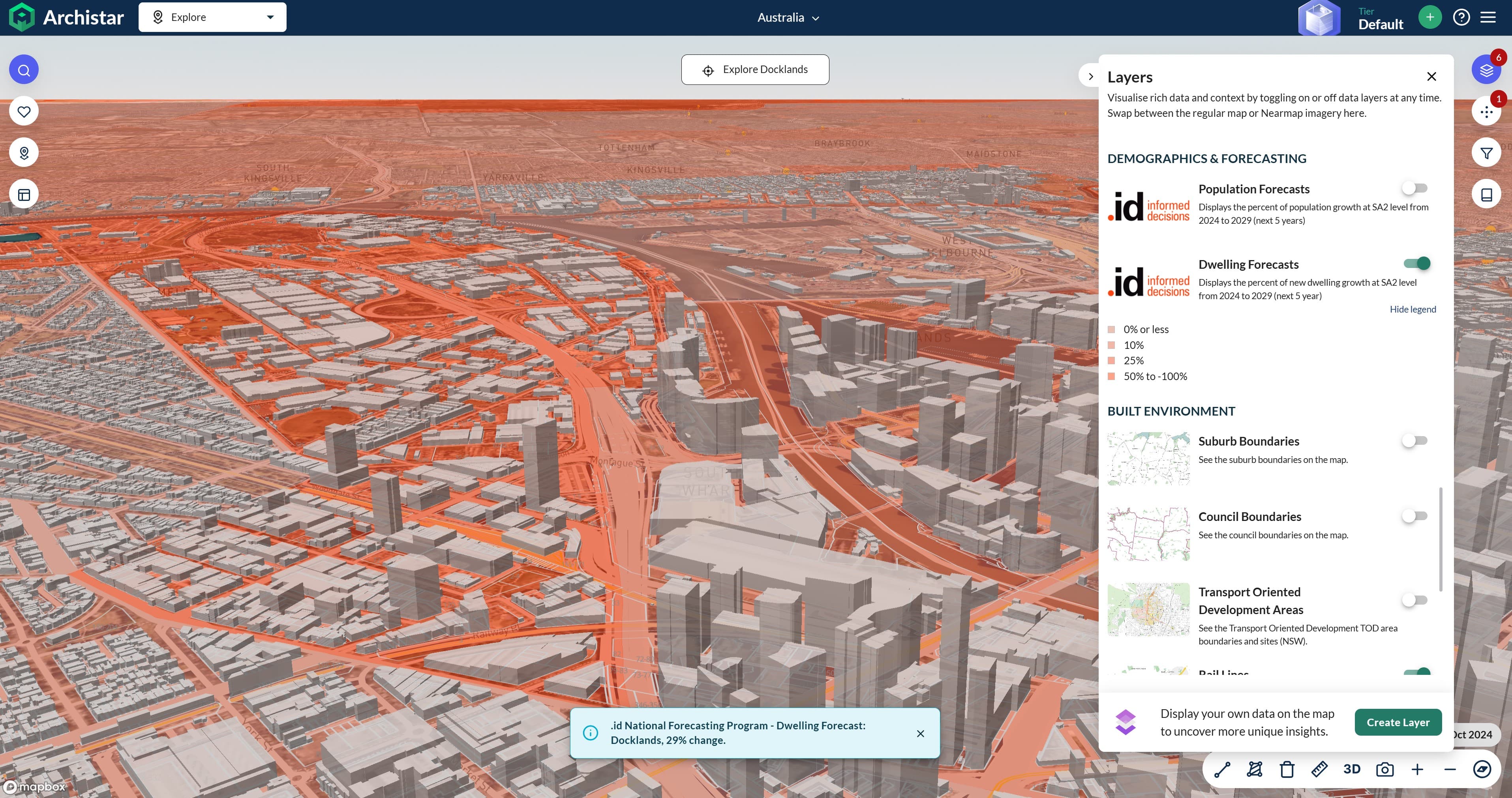BLOG
How close did we get? Comparing .id’s Small Area Forecast information with population estimates
How close did we get? Comparing .id’s Small Area Forecast information with population estimates
As population forecasters, we eagerly awaited the release of detailed Census data, as it provides an important input into our Small Area Forecast information (SAFi) population forecasts. When the Australian Bureau of Statistics (ABS) releases the subsequent rebased Estimated Resident Population (ERP), it gives us a chance to review how well .id’s small area forecasts performed in relation to the official population. In this blog, I review the performance of .id’s SAFi population forecasts in relation to the published ERPs and explore the impact of using ERPs as constraints in our forecasts.
Australia’s Census provides us with an updated population count and number and type of dwellings. We use this Census data to build our knowledge of how Australia’s towns, cities and remote communities are growing and changing over time.
Please note: this assessment focuses on .id SAFi – the performance of .id’s local government population forecasts (forecast.id) is not included in this assessment.
A snapshot of how we develop population forecasts
Population forecasts are based on assumptions about how the population will change in the future, using data and knowledge of the recent past. When we develop our small area population forecasts, we incorporate a range of official statistics and data sources to ensure robust, granular information. Read more about what goes into developing SAFi here.
Annually, we incorporate official statistics published by the ABS including the number and location of births and deaths, estimated resident population, and building approvals.
SAFi is modelled using a combination of “tops-down” demographic constraints (national and state-based population parameters) and detailed “bottoms-up” assumptions about residential housing stock and the households that occupy these dwellings. Australia’s official population count, the ERP, is used as a constraint for our demographic assumptions.
The ABS regularly adjust the ERP using the most recent information (updated quarterly for Australia, state and territory level estimates and annually for sub-state level estimates). Every 5 years when the new Census data becomes available, the ABS “rebase” the ERP to align to the most recent population count. This rebased ERP becomes the new starting point for subsequent updates to the population estimates. Read more from the ABS about rebasing Australia’s population estimates using the 2016 Census.
How did we go at forecasting the population?
Given our SAFi forecasts are tied so closely to the annually updated ERP, it’s no surprise that our state and territory forecasts are close to the 2016 based estimated resident population. We can assess the performance of our population forecasts in terms of the numeric and percentage difference, summarised in the table below where we compare the ABS Estimated Resident Population figures (based on the old 2011 Census and new 2016-based Census) alongside the .id SAFi population forecasts for 2016.
For Australia, the ABS performed similarly to .id SAFi at determining the (rebased) population in 2016. We slightly underestimated the population change from 2011 to 2016, resulting in a difference of 93,800 (0.39%) compared with the ABS’ difference of 81,900 (0.34%). These differences are quite small as we use the most recently available ERP as a constraint for our demographic modelling.
In most cases, the SAFi estimates were very close to the official ABS ERP numbers. Victoria and Western Australia were amongst the largest variances, with some interesting population trends taking place following the end of the mining boom. Read more about ABS revisions to the ERPs for Victoria and Western Australia.
Comparison of ABS population estimates and SAFi population forecasts, as at 30 June 2016
| State/ Territory | 2011-based ERP1 | SAFi forecast2 | 2016-based ERP 3 | Difference between 2011 and 2016-based ERP | Difference (%) | Difference between SAFi forecast and 2016-based ERP2 | Difference (%) | ||||
|---|---|---|---|---|---|---|---|---|---|---|---|
| As at 30 June 2016 | |||||||||||
| New South Wales | 7,726,924 | 7,713,025 | 7,739,274 | 12,350 | 0.16% | 26,249 | 0.34% | ||||
| Victoria | 6,069,636 | 6,062,136 | 6,179,249 | 109,613 | 1.81% | 117,113 | 1.90% | ||||
| Queensland | 4,843,303 | 4,842,442 | 4,848,877 | 5,574 | 0.12% | 6,435 | 0.13% | ||||
| South Australia | 1,708,135 | 1,707,555 | 1,713,054 | 4,919 | 0.29% | 5,499 | 0.32% | ||||
| Western Australia | 2,617,074 | 2,618,986 | 2,558,951 | -58,123 | -2.22% | -60,035 | -2.35% | ||||
| Tasmania | 519,063 | 518,657 | 517,588 | -1,475 | -0.28% | -1,069 | -0.21% | ||||
| Northern Territory | 245,191 | 245,231 | 245,740 | 549 | 0.22% | 509 | 0.21% | ||||
| ACT | 396,294 | 405,212 | 403,468 | 7,174 | 1.81% | -1,744 | -0.43% | ||||
| Other Territories 4 | 3,256 | 3,722 | 4,608 | 1,352 | 41.52% | 886 | 19.23% | ||||
| Australia | 24,128,876 | 24,116,967 | 24,210,809 | 81,933 | 0.34% | 93,842 | 0.39% | ||||
Sources/Notes:
- 2011-base 2016 ERP preliminary status, ABS cat. no. 3101.0, published 15 December 16.
- SAFi forecast is the adjusted ERP which matches the published ERP as at 30 June 2015, apart from the adjustments discussed in this blog, source Australian Bureau of Statistics, cat. no. 3101.0, March 2016 qtr published 22 September 2016. The 2016 ERP figure produced by SAFi is a forecast based on the most recent published ABS data at the time of production.
- 2016-base 2016 ERP preliminary status, ABS cat. no. 3101.0, published 27 June 17.
- Population for ‘Other Territories’ is derived. The population of Norfolk Island was added to ‘Other Territories’ in 2016, it was previously excluded from Australia’s population.
Using official statistics
It’s important to note that the quality and accuracy of input statistics are a major factor in how well population forecasts perform – forecasts can only be as good as the assumptions and input data they are based on.
During our 2016 SAFi production cycle, as we analysed changes to known dwelling stock through sources including aerial photography and building approvals, we identified a state and a territory (ACT and Tasmania) where we felt a departure from the existing methodology was warranted.
Currently, the SAFi team is on the home-straight with updating Victorian SAFi population and dwelling forecasts. We are revelling in the chance to analyse and incorporate the latest census results in our work.
Future blogs will examine how well our SAFi forecasts performed against state and territory population projections at the LGA level, and also what we have learnt from the 2016 Census to help our population forecasts.
.id is a team of demographers, population forecasters, spatial planners, urban economists, IT and data experts who use a unique combination of online information applications and consulting services to help governments and organisations understand people and places for evidence-based planning. We share our online demographic resources and tools to help you make evidence-based decisions – check out our Demographic resource centre.
Esther - Team Forecast
Esther joined .id after working in the demography teams at both Statistics New Zealand and the Australian Bureau of Statistics producing national and regional statistics. Esther produces the top-down model for .id’s SAFi (Small Area Forecast information). This involves synthesising overseas, interstate and regional migration patterns to quantify regional change. Esther loves the way statistics assist in understanding our communities and can dispell urban myths or stereotypes.


.png)






